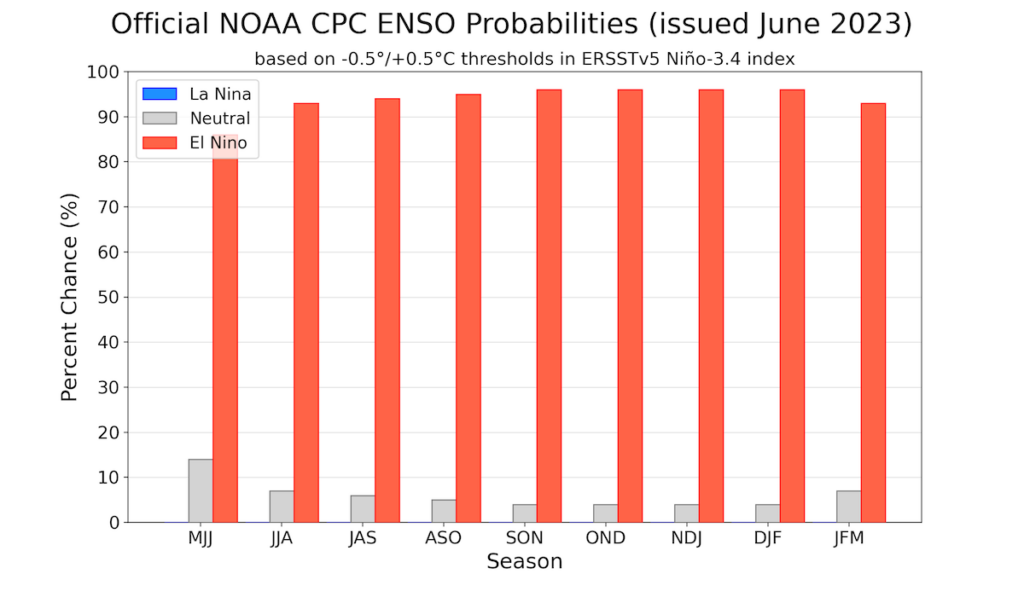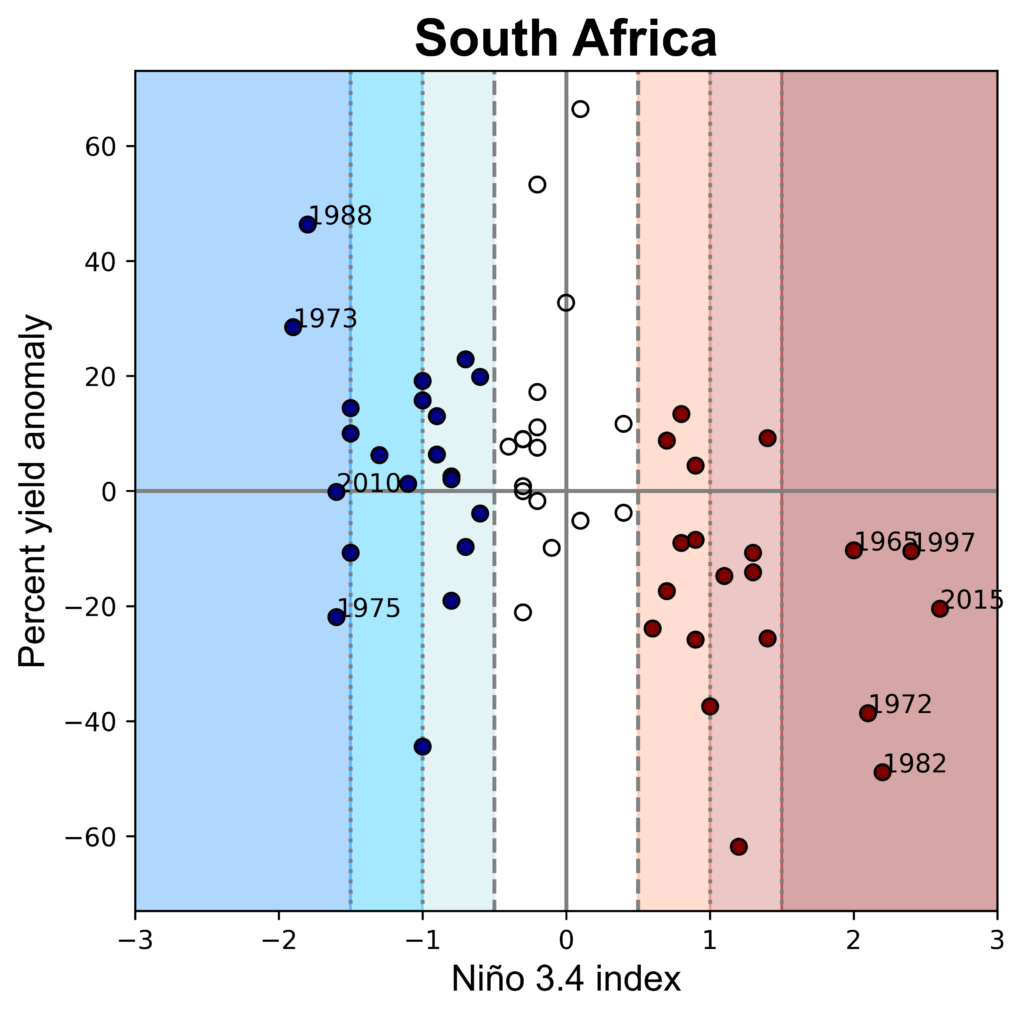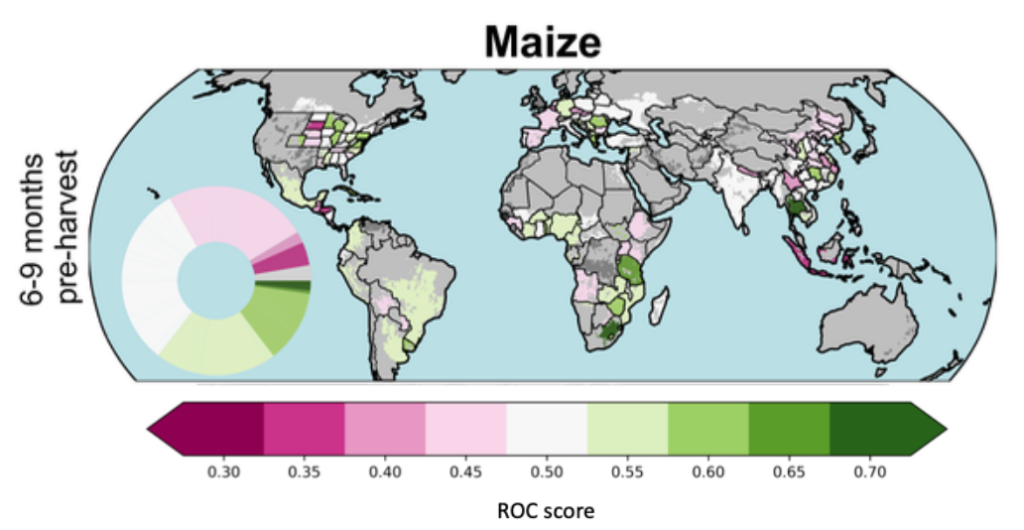Extreme weather is one of the primary drivers of crop failures around the world.
Crop failures – the total or near-total loss of a farm or region’s crops – greatly reduce the availability of food and can have dire consequences for food security.
They also reduce the need for agricultural labour, cutting off critical income streams for farmworkers and further exacerbating food insecurity.
As a result, predicting such crop failures is a crucial component of food security early-warning systems.
Over the past year, my colleagues and I have been providing experimental pre-season crop yield outlooks to the Famine Early Warning Systems Network, based on existing forecasts of the El Niño-Southern Oscillation (ENSO).
ENSO is a large-scale mode of climate variability that influences global patterns of temperature and rainfall. These influences mean that ENSO has a critical role in dictating crop success or failure.
Our new paper, published in Nature Communications, demonstrates that, in some locations, crop yield shocks can be predicted more than six months ahead of time and – in certain cases – before a crop is even planted.
Given the considerable logistical challenges of responding to food insecurity, predicting low yields this far in advance could be a valuable tool for helping to alleviate the impacts of crop failures.
Crop conditions
The US Agency for International Development established the Famine Early Warning Systems Network (FEWS NET) in 1985 in response to famines that had devastated east and west Africa in the years prior.
Today, FEWS NET monitors more than 30 countries in sub-Saharan Africa, Latin America, the Caribbean, the Middle East and Asia. It produces thrice-yearly outlooks of food insecurity that predict the level of acute food insecurity that is most likely to occur in the eight months ahead.
These projections are based on a range of evidence, using information on climate forecasts, staple food and commodity prices, seasonal labour demand, livestock health, pest infestations, government and international aid and conflict.
Because ENSO is the primary source of seasonal climate forecast skill for rainfall, it plays an important role in predicting droughts during upcoming cropping seasons.
In this context, our system builds on ENSO forecasts to provide an additional line of evidence to forecast the possibility of poor yields associated with ENSO.
The development of a long-range crop yield outlook system has been timely, albeit for troubling reasons.
This past growing season in southern Africa has seen a record-breaking drought that has led to widespread crop failures, including reductions in maize production topping 50% in Zimbabwe, 30% in Zambia, 30% in Malawi and 10% in South Africa.
The map below shows the end-of-season crop conditions for maize in southern Africa at the end of June. Large swathes of Zimbabwe, Zambia and southern Malawi experienced failure conditions (dark red shading). The majority of these negative conditions were caused by dry, hot weather.
According to FEWS NET, these crop failures have left upwards of 30 million people in need of emergency food assistance.
But the poor harvests in southern Africa were not only predictable, they were accurately predicted.
FEWS NET warned of the potential impact of an ENSO event more than a year ahead of harvest and began to warn of likely impacts as early as nine months ahead of harvest.
Such warnings demonstrate that we can effectively use predictable elements of climate variability in food security early warning systems at pre-season lead times – that is, before a crop is planted at the beginning of the growing season.
El Niño and crop yields
While claims of predicting droughts and crop failures prior to planting may seem outlandish, the foundation for doing so has been recognised for more than three decades.
The predictability of ENSO is so great that in June of 2023, the official forecast from the US National Oceanic and Atmospheric Administration (NOAA) for the three-month span starting in December was for a 95% probability of El Niño conditions.
This can be seen in the chart below, which shows the probability of a warm El Niño event (red), a cool La Niña (blue) or a neutral year (grey). The outlook covers a 10-month span in a rolling three-month window.

Just as ENSO influences patterns of rainfall globally, it also contributes to changing patterns of crop production.
In South Africa, for example, 16 of the last 21 El Niño events resulted in below-expected maize yields, stretching back to 1961. As the major breadbasket of southern Africa, the strength of this relationship has important implications for early warnings in the region.
The figure below shows the relationship between El Niño and maize yield in South Africa. Generally speaking, higher-than-average yields are associated with La Niña events (blue shading), while lower-than-average yields are associated with El Niño years (red).
The x-axis shows the Niño 3.4 index, which is based on sea-surface temperatures in the Pacific Ocean around the equator. El Niño and La Niña events are defined by a period lasting at least six months where the sea-surface temperatures are at least 0.5C higher or lower than the average, respectively.
The y-axis shows the deviations from expected maize yield in a given year, where the expected yield is adjusted to account for changing technologies and management practices over time.

This concept is not particularly new. That the predictability of ENSO could be combined with its influence on crop production was recognised as early as the mid 1990s, when Cane et al. (1994) proposed to use ENSO forecasts to predict maize yields in Zimbabwe.
The authors demonstrated that forecasts of ENSO matched observed maize yields well. However, their analysis was confined to Zimbabwe – and it was never translated into an operational system.
Predicting yields
Our recent paper picks up where Cane et al. left off to build a global crop production forecast system for maize and wheat.
We build on their original methodology by incorporating probabilistic forecasts of ENSO, expanding the analysis to cover the entire globe and exploring the predictability of both maize and wheat yields.
Most significantly, our preseason forecast system significantly extends the lead time of current crop yield forecasts.
Our research combines multi-year forecasts of ENSO with its historical impacts on crop yields, derived from 60 years of crop yield data. Our findings show that – at least in some countries – crop yield forecast skill extends well beyond the mid-season forecasts that dominate current crop yield forecasting systems.
In our forecasting system, maize and wheat forecasts are skilful at lead times of up to a year ahead of harvest for 15% and 30% of harvested areas, respectively. While that is only a fraction of total harvested area, it is remarkable that this is possible anywhere on Earth.
What’s more, the forecast skill for maize is greatest in south-east Africa, indicating that food crises like the recent crop failures across south-eastern Africa can be anticipated well in advance.
The map below shows the areas where the forecast model is skilful at predicting maize yield.
Green represents places where the model is skilful, with darker colours meaning higher skill level. Pink represents areas where the model is less skilful than random chance, with darker colours meaning lower skill. White areas on the map are places where the model has no predictive skill above random chance. Grey parts of the map are places where maize is not grown.
It is most skilful in parts of south-eastern Africa, as well as parts of south-east Asia, whereas in western Europe, it has no skill relative to random chance. This is reflective of the strength of the influence of El Niño on the climate in a given area.

The significance of our findings is not simply in the results themselves, but also as a demonstration that the potential for pre-season crop yield forecast skill.
There has been little research put towards developing such long-range forecast systems. But our results demonstrate that even with a simple model, it is possible to produce a skilful, reliable forecast for some parts of the world at pre-season lead times.
Implementing programmes that anticipate and respond to food crises requires months of notice. Estimating the population in need, securing the funds for disaster response, procuring and distributing food aid and scaling up nutrition assistance programmes all take time. In addition, for many anticipatory actions – such as distributing drought-tolerant seed varieties or switching which crops are planted – only forecasts ahead of planting can be used.
For all these reasons, it is important that the research community identify both the promise and limitations of pre-season crop yield forecasts.
Anderson, W. et al. (2024) Preseason maize and wheat yield forecasts for early warning of crop failure, Nature Communications, doi:10.1038/s41467-024-51555-8
Sharelines from this story


